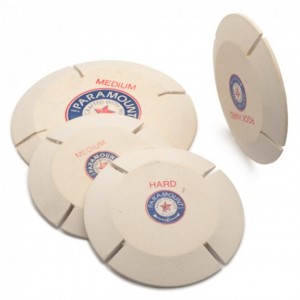In the highly competitive landscape of polishing tool manufacturing, a revolutionary transformation in the wool felt wheel production process has emerged, setting a new standard for precision craftsmanship. This breakthrough not only elevates the quality of wool felt wheels but also unlocks unprecedented performance capabilities.
The new – generation manufacturing process begins with a meticulous selection of wool fibers. Manufacturers are now sourcing premium – grade wool from specific regions renowned for their superior quality. These carefully chosen fibers possess unique characteristics such as consistent thickness, high tensile strength, and excellent elasticity, laying a solid foundation for the production of top – notch wool felt wheels.
Advanced carding and felting techniques play a pivotal role in the new process. Unlike traditional methods, modern carding machines are designed to align the wool fibers in a more uniform manner, creating a dense and even structure within the felt. This precise alignment significantly enhances the wheel’s polishing efficiency and durability. The felting process has also been optimized, with the introduction of state – of – the – art hydraulic presses and temperature – controlled systems. These technologies ensure that the wool fibers bond together firmly, resulting in a felt wheel that can withstand high – speed rotation and intense polishing pressures without shedding or deforming.
Another remarkable innovation in the manufacturing process is the application of nanocoating technology. By applying a thin layer of nanomaterials to the surface of the wool felt wheel, manufacturers can endow it with additional properties. For instance, a hydrophobic nanocoating can prevent the absorption of polishing compounds and debris, making the wheel easier to clean and maintain. Meanwhile, a wear – resistant nanocoating can extend the wheel’s lifespan by reducing friction and protecting the wool fibers from abrasion.
The impact of this manufacturing revolution is being felt across multiple industries. In the precision engineering sector, where minute surface imperfections can affect the performance of high – tech components, the new – generation wool felt wheels are enabling more accurate and consistent polishing results. For example, in the production of semiconductor wafers, these wheels can achieve a surface roughness level that was previously unattainable, ensuring the reliability and efficiency of electronic devices.
In the luxury goods industry, which demands flawless finishes for products like high – end watches and jewelry, the enhanced precision of wool felt wheels has become a game – changer. Craftsmen can now use these wheels to create intricate polishing patterns and achieve mirror – like surfaces on precious metals and gemstones, adding significant value to the final products.
Industry insiders believe that this manufacturing process revolution will not only drive the growth of the wool felt wheel market but also inspire further innovation in the broader field of polishing tools. As more manufacturers adopt these advanced techniques, we can expect to see even more sophisticated and high – performing wool felt wheels in the future, meeting the evolving needs of various industries.

Post time: Jun-10-2025
